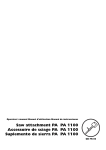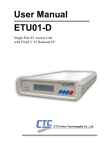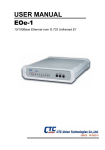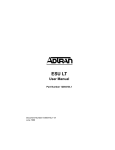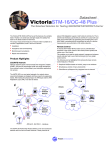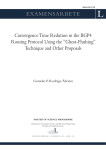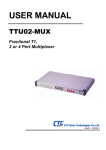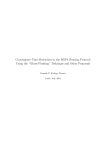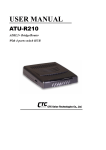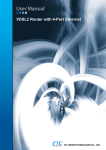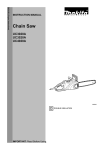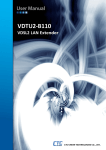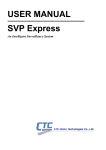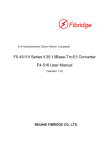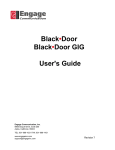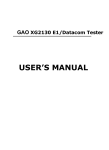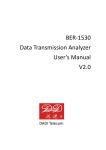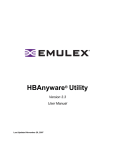Download ETU01C User Manual
Transcript
User Manual ETU01C Dual Port E1 Access Multiplexer with Sub E1 CTC Union Technologies Co., Ltd. CTC Union Technologies Co., Ltd. Far Eastern Vienna Technology Center (Neihu Technology Park) 8F, No. 60 Zhouzi St. Neihu, Taipei 114 Taiwan Tel: +886-2-26591021 Fax: +886-2-27991355 Email: [email protected] URL: http://www.ctcu.com ETU01C User manual version 1.0 Sept. 2005 User Manual for Dual Port E1 Access Multiplexer with Sub E1 Thank you for choosing our product. Please read this manual carefully before using the ETU01C. This manual supports the following models: ETU01C 100-240 VAC model ETU01C –48V DC model Copyright © 2005, CTC Union Technologies, Inc. All rights reserved. All specifications are subject to change without prior notice. Table of Contents Chapter 1. Introduction 1.1 Introduction ...............................................................................................7 1.2 Functional Description ..............................................................................7 1.3 Typical System Applications......................................................................8 1.4 E1 signal structure.....................................................................................8 1.5 ETU01C Capabilities...............................................................................10 1.6 TECHNICAL SPECIFICATIONS..........................................................12 Chapter 2. Installation 2.1 General.....................................................................................................15 2.2 Site Preparation .......................................................................................15 2.3 Mechanical Assembly ..............................................................................15 2.4 Electrical Installation...............................................................................15 Chapter 3. Front Panel Operation 3.1 GENERAL...............................................................................................19 3.2 CONTROLS AND INDICATORS ..........................................................19 3.3 Menu Operation.......................................................................................20 Chapter 4. Control Port Operation 4.1 General.....................................................................................................30 4.2 Terminal Connection ...............................................................................30 4.3 Menu System Detail .................................................................................31 Chapter 5. Diagnostic Tests 5.1 Test Loops................................................................................................51 Appendix A........................................................................................................59 Technical Inquiry Form Table of Contents Chapter 1 Introduction 1.1 Introduction The ETU01C provides an economic multiplexing solution for Fractional E1 network services. Two DTE devices may be linked to the ETU01C at combined data rates of 64kbps to 2048kbps.The ETU01C also provides one E1 sub-link which may be connected over a public E1 network. The E1 sub-link will perform Drop&Insert with user-defined timeslot connections from a PABX or other E1 equipment to E1 network services. The ETU01C supports local control and diagnostics via the front panel LCD and a serial RS-232 craft port. This feature enables users to easily configure the unit, execute the in-service diagnostics and monitor the network status. 1.2 Functional Description The ETU01C data channels support user-selectable transmission rates, which are integer multiples of 64kbps, up to a maximum 2.048Mbps on twisted pair or coax cable. The ETU01C has two jumper selectable interfaces; RS-530 or V.35. Adapter cables are required to connect client equipment for V.35, X.21 or RS-449. The ETU01C fully meets all of the E1 specifications including ITU G.703, G.704, G.706, G.732, and G.823. Multiple clock source selection provides maximum flexibility in connecting both the E1 and user interfaces. The ETU01C has the flexibility to meet the timing requirements of various system configurations. The timing modes for the E1 link and for the user channel are selected by the setting of configuration data via the front panel LCD display, or terminal mode console port. The E1 link may be clocked from the E1 recovered receive clock (main E1 link or sub E1 link), from the user data ports, or from the internal oscillator. The ETU01C provide IDLE CODE mode, you can set any time slot and insert the idle code with ‘00'-‘FF', and the default code is ‘7F'. The ETU01C includes a BERT generator and receiver which may internally connect to either main or sub E1 or to either data channel. The ETU01C is available in either AC or DC models. Voltage models include AC (100-240VAC) or DC (18-72VDC). An internal relay ensures that the main to sub E1 is connected even if the system is powered off. 7 Chapter 1 Introduction 1.3 Typical System Applications General Hyper Terminal Channel 1 Router V.35/RS530 E1 Network ETU01C PABX Channel 1 Router V.35/RS530 Ethernet Ethernet Router V.35 * 2 LAN Sub E1 Router V.35 * 2 E1 Network ETU01C ETU01C Sub E1 LAN E1 PABX PABX Figure 1-1: Example; Typical Application In a typical application (Figure 1-1), the ETU01C is used to connect the synchronous data channels of two routers and the local and remote LANs over an E1 line. The fractional E1 data service is based on the assumption that the combined user data rate of all channel modules plus Sub-Link is equal to or is a fraction of the full available E1 bandwidth, in multiples of 64K. Up to two data channels may be connected plus an optional E1 sub-link. 1.4 E1 signal structure The E1 line operates at a nominal rate of 2.048Mbps. The data transferred over the E1 line is organized into frames, with each E1 frame containing 256 bits. The 256 bits are organized as 32 time slots of eight bits each and carry the data payload. 8 Chapter 1 Introduction E1 transmissions utilize two main types of framing: Frame Alignment Signal (FAS) and Multi-Frame Alignment Signal (MFAS). Framing is necessary in order for equipment receiving the E1 signal to be able to identify and extract the individual channels. PCM-30 (CAS) transmission systems use MFAS framing along with FAS framing. PCM-31 (CCS) transmission systems use only FAS framing. Frame Alignment Signal (FAS) The 2.048 Mbps frame consists of 32 individual time slots (numbered 0-31). As described previously, each time slot consists of an individual 64 Kbps channel of data. In the FAS format, time slot 0 of every other frame is reserved for the frame alignment signal pattern. Alternate frames contain the FAS Distant Alarm indication bit and others bits reserved for national and international use. Multi-Frame Alignment Signal (MFAS) MFAS framing uses Channel Associated Signaling (CAS) to transmit the A/B/C/D bits signaling information for each of 30 channels. This method uses the 32 time slot frame for mat with time slot 0 dedicated for the Frame Alignment Signal (FAS) and time slot 16 dedicated. For the MultiFrame Alignment Signal (MFAS) and the Channel Associated Signaling (CAS). E1 line signal The basic E1 line signal is coded using the Alternate Mark Inversion (AMI) or HDB3 rule. In the AMI format, "ones" are alternately transmitted as positive and negative pulse, whereas "zeros" are transmitted as a zero voltage level. AMI is not used in most 2.048 Mbps transmissions because synchronization loss occurs during long strings of data zeros. In the HDB3 format, a string of four consecutive zeros is replaced with a substitute string of pulses containing an intentional bipolar violation. The HDB3 code substitutions provide high pulse density so that the receiving equipment is able to maintain synchronization with the received signal. 9 Chapter 1 Introduction 1.5 ETU01C Capabilities E1 link line coding The ETU01C supports two E1 line codes: AMI coding. HDB3 coding. E1 framing formats The ETU01C supports three formats: Unframed format. (in Unframed, only Data port 1 is supported) FAS (CCS, PCM-31) format. (TS0 reserved) MFAS (CAS, PCM-30) format. (TS0 and TS16 reserved) User data channel rates The ETU01C supports each user data channel rates which are a multiple of 64kbps. For maximum flexibility, the ETU01C supports combined data rates up to 2.048Mbps.The ETU01C supports flexible time slot assignment, allowing the user to freely specify the selection of time slots, in sequence or randomly, for each data channel. User data channel interface The ETU01C has two user data channel interfaces (CHANNEL 1 and CHANNEL 2) and two types of user data channel interfaces: V.35 or RS-530 (X.21, RS-449). The desired interface is achieved by jumper settings in the ETU01C. The ETU01C supports any two interface settings for the two user data channel interfaces. System Timing Considerations The ETU01C has the flexibility to meet the timing requirements of various system configurations. The timing mode for the E1 link and for the user channel are selected by the setting of configuration data via the front panel LCD display. E1 link timing The ETU01C E1 link receive path always operates on the receive clock. The ETU01C recovers the receive clock from the received E1 link data signal. The source of the ETU01C E1 link transmit clock can be selected by the user. 10 Chapter 1 Introduction The following E1 link transmit timing modes are available. Loop back timing The ETU01C E1 link transmit clock is locked to the recovered receive clock (Main link E1 or Sub link E1). This is usually the timing mode selected for network operation. Internal timing The ETU01C E1 link transmit clock is derived from the internal clock oscillator. This timing mode is necessary in point-to-point applications over leased line. In this case, one ETU01C must use the internal oscillator, and the others must operate from the recovered clock. External timing The ETU01C E1 link transmit clock is locked to the clock signal provided by the user DCE connected to one of the user's data channels. When the data channel is used as the clock source, the data channel must use clock timing mode 2 (DTE). User data channel timing The ETU01C has two user data channel clocking modes: Clock mode 1 (DCE) The ETU01C data channel operates as a DCE providing the transmit and receive clocks (recovered timing) to the data terminal equipment connected to the user channel. The clocks are locked to the master timing. Clock mode 2 (DTE) The ETU01C data channel operates as a DTE (crossover cable required) and accepts both transmit clock and receive clock (both from the ETC pin) from the user DCE equipment. 11 Chapter 1 Introduction 1.6 TECHNICAL SPECIFICATIONS Main E1 and sub E1 links Framing Bit Rate Line Code Line Impedance Relative Receive Level "Pulse" Amplitude "Zero" Amplitude Tx Frequency Tracking Internal Timing Loop back Timing External Timing Jitter Performance Complies With Interface Connectors User Data Channels Interface Types Interface Connectors Data Rate Clock Modes Control Signals Time slot allocation -Unframed/Framed (sub link framed only) -FAS (PCM31) -FAS+CAS (PCM30) -CRC4 ON/OFF 2.048 Mbps -AMI -HDB3 -Unbalanced 75 ohms -Balanced 120 ohms 0 to -43dB -Nominal 2.37V+/-10% for 75 ohms -Nominal 3.00V+/-10% for 120 ohms 0.1V +/-30 ppm +/-50 ppm +/-100 ppm According to ITU-T G.823 ITU-T G.703, G.704, G.706 and G.732 -RJ45 -BNC -RS-530 -V.35 RS-530/V.35 25 pin, D-type Female N*64kbps Where N equal 1 to 31 in CCS And N equal 1 to 30 in CAS -Clock Mode 1 (DCE): Receive and transmit clock (recovered) to the Synchronous DTE -Clock Mode 2 (DTE): Receive and transmit clock from the synchronous DCE (all from ETC pin). -CTS constantly ON or follows RTS -DSR constantly ON, except during test loops -DCD constantly ON, except during signal loss User defined, randomly assignable 12 Chapter 1 Introduction Setup/Configuration LCD Pushbutton Switches 2 rows of 16 characters -ESC -Left Arrow -Right Arrow -Enter LED indicators Figure1-2 ETU01C Front Panel 1. Power Dual Color LED GREEN: Power RED: Test 2. Error (Only active in BERT mode) RED: Pattern Error 3. Main E1 (include Signal loss, SYNC Loss) Dual Color LED GREEN: SYNC OK RED : Signal Loss RED flashing: SYNC Loss LIGHT OFF: Main E1 chip failure 4. Alarm of Main E1 RED OFF: NO E1 Alarm RED ON: E1 Alarm ( AIS, RAI, MRAI ) 5. Sub E1 (include Signal Loss, SYNC Loss) Dual Color LED GREEN : SYNC OK RED : Signal Loss RED flashing : SYNC Loss LIGHT OFF : Sub E1 chip failure 6. Alarm of Sub E1 RED OFF: NO E1 Alarm RED : E1 Alarm ( AIS, RAI, MRAI ) 13 Chapter 1 Introduction 7. CH1-TD of Datacomm ON :DATA 1 FROM DTE OFF : DATA 0 FROM DTE flashing : DATA 0 and 1 FROM DTE 8. CH1-RD of Datacomm ON : DATA 1 FROM Main E1 OFF : DATA 0 FROM Main E1 flashing : DATA 0 and 1 FROM Main E1 9. CH2-TD of Datacomm ON :DATA 1 FROM DTE OFF : DATA 0 FROM DTE flashing : DATA 0 and 1 FROM DTE 10. CH2-RD of Datacomm ON : DATA 1 FROM Main E1 OFF : DATA 0 FROM Main E1 flashing : DATA 0 and 1 FROM Main E1 RS-232 CONSOLE port Port interface V.24/RS-232 asynchronous, DCE Port connector 9 pin D-type female Data rate 19200 bps Data format -1 start bit -8 data bits -No parity -1 stop bits Alarm relay -Floating pair of NO and NC contacts -Contact ratings: 1A at 30 VDC resistive or 0.5A at 125 VAC resistive Physical Height: 44 mm Width: 195 mm Depth: 245 mm Weight: 925g net Power supply Voltage (AC model) 100 ~ 240 VAC Voltage (DC model) 18 ~ 72 VDC Frequency 47 to 63 Hz for AC power Power consumption 15 VA Environment Temperature 0-50C / 32-122F Humidity 0 to 90% non-condensing 14 Chapter 2 Installation 2.1 General This chapter provides detailed instructions for mechanical installation of the ETU01C. Following the completion of installation, please refer to Chapter 3 for front panel operating information and Chapter 4 for console port operating information. 2.2 Site Preparation Install the ETU01C within reach of an easily accessible grounded AC outlet. The outlet should be capable of furnishing 100 to 240 VAC. Allow at least 10cm (4 inch) clearance at the rear of the ETU01C for signal lines and interface cables. 2.3 Mechanical Assembly The ETU01C is designed for tabletop, shelf or rack mount installation, and except for rack mount installation, is delivered completely assembled. Rack mounted applications require installation of additional rack mounting brackets. No provisions are made for bolting the ETU01C to the tabletop. 2.4 Electrical Installation 2-4-1. Power connection AC power is supplied to the ETU01C through a "Mickey Mouse" type plug. The ETU01C should always be grounded through the protective earth lead of the power cable. 2-4-2. Rear panel connectors The data channel interfaces are fixed on the rear panel of the ETU01C (Refer to Figure 2-1) and consist of DB25pin connectors for RS-530 and V.35. Two RJ-45 interfaces and two pairs of BNC Coax connectors for the main E1 and E1 sub-link. The last connector is a DB9pin connector for the terminal mode console port. Figure 2-1 ETU01C rear panel (AC model) 15 Chapter 2 Installation E1 Line side BNC coax connector Two BNC coax pair of connectors marked RX and TX, provide unbalanced 75 Ohm connections for the Main E1 and Sub E1 lines. RJ-45 INTERFACE Two RJ-45 connectors marked Sub E1 and Main E1, provide balanced 120 Ohm connections for the Main E1 and Sub E1 lines. The pin assignments for RJ-45 connectors are as follows: 1 RTIP (Receive data in) 2 RRING (Receive data in) 4 TTIP (Transmit data out) 5 TRING (Transmit data out) Note: This follows the USOC RJ-48C standard. Data Port Settings Data Port 1 setting J200 V35 1-2 RS530 2-3 J201 1-2 2-3 J202 1-2 2-3 J700 2-3 1-2 Data Port 2 setting J300 V35 1-2 RS530 2-3 J301 1-2 2-3 J302 1-2 2-3 J701 1-2 2-3 16 Chapter 2 Installation 123 J301 J302 J300 J303 J203 J201 J202 J200 123 123 J701 J700 Figure 2-2 Data port jumper settings 17 Chapter 2 Installation This page left blank intentionally. 18 Chapter 3 Front Panel Operation 3.1 GENERAL This chapter describes the ETU01C controls and indicators, and explains operation setup procedures using the front panel LCD and menu keys. Installation procedures (in Chapter 2) must be completed and checked before attempting to operate the ETU01C. 3.2 CONTROLS AND INDICATORS All controls (push-button switches), LCD display and LED indicators are located on the ETU01C front panel. The momentary on pushbutton switches are used to activate menu selections and select parameter settings. Figure 3-1: ETU01C Front Panel Use the ‘LEFT' and ‘RIGHT' function keys to browse the menus and select parameters. Use the ‘ESC' function key to return to a previous menu or to abandon setup. Use the ‘Enter' function key to set a parameter of a selection or to enter a sub-menu. 19 Chapter 3 Front Panel Operation 3.3 Menu Operation 3.3.1 Top Level Menus The following are the 8 top level Menus. Press an arrow key (LEFT or RIGHT) to select another top level Menu or press ENTER to reach a sub menu. For normal transmissions, the unit must be in 'RUN' mode. RUN ON >>>>>>>>>>>>>>>> When powered on, the ETU01C will work under the last saved setting. Press ESC to stop the running, and the LCD will display: < SYSTEM PARAMETER > Set the default system parameter, save the present parameter, reset the system, and choose the system clock. < MAIN E1 LINK > PARAMETER Set the Line code, interface and distance, transmit buffer, receive buffer, Frame type, and idle code for main E1 link. < SUB E1 LINK > PARAMETER Set the Line code, interface and distance, transmit buffer, receive buffer, Frame type, and idle code for sub E1 link. < TIME SLOT MAPPING > 20 Chapter 3 Front Panel Operation Assign the E1 timeslots to the Data Channels and/or E1 sub-link. < DATA PORT PARAMETER > Data Port informational screen and settings for Clock Mode, Clock Polarity and Handshaking. < LOOPBACK PARAMETER > Enable main link, sub-link, or data channel Loop back. < BERT TEST PARAMETER > Enable BERT, select channel and select pattern. < EXIT CONFIG > **************** Exit the configuration and run the ETU01C. 3.3.2 System Parameter Detail The following screens show the setup screens under the System Parameter Main Screen. SYSTEM PARAMETER 21 Chapter 3 Front Panel Operation Press ENTER; the SYSTEM PARAMETER sub-menu will be displayed.You can modify all the system parameters, save all changes, or reset the unit back to the default settings. DEFAULT Press ENTER, the ETU01C will work in the default mode. SAVE SET Press ENTER, the ETU01C will store all the parameters as current settings. The next time the ETU01C is powered on, all the parameters used will be those that were previously saved. NOTE: Remember to save the parameters if you want to commit the ETU01C with the current parameters. If not, the ETU01C will resume all the parameters from the last saved settings when it is powered on the next time. RESET SYSTEM Press ENTER, the system will be reset to factory defaults. ***BE CAREFUL, THERE IS NO FURTHER CONFIRMATION*** < SYSTEM CLOCK > INTERNAL Press ENTER to set the system clock: Internal/External(P1、P2)/Recovery(Main E1、Sub E1). NOTE: Only one of the two DTE equipments connected to the two Data Ports can be set as DTE clock source at any one time, and the system clock must be set as the External Clock from the correct Data Port. 22 Chapter 3 Front Panel Operation For example, if the equipment connected to the Data Port 1 is set as DTE clock, the system clock of ETU01C must be set as External Clock from Data Port 1(External P1). 3.3.3 Main E1 Parameter Detail The following screens show the setup under the Main E1 Parameter. < MAIN E1 LINK > PARAMETER Press ENTER and the MAIN E1 LINK sub-menu will be displayed. Main E1 Link sets the LINE CODE, IMPEDANCE, LBO, TX JITTER, RX JITTER, FRAME type and CRC mode for the mainE1 of the ETU01C. < LINE CODE [HDB3] > Use the arrow keys to browse the individual link parameters (frame, CRC, etc.) Press ENTER on the parameter to select it with the cursors. Now use the arrow keys to browse the available settings for that parameter. The following is a breakdown of parameters and available settings: LINE CODE: HDB3 or AMI, HDB3 default. IMPEDANCE: 120ohm or 75ohm, 120ohm default. LBO: SHORT or LONG, SHORT default. TX JITTER: ON or OFF, OFF default. RX JITTER: ON or OFF, OFF default. FRAME: unframed, CCS or CAS, unframed default. 3.3.4 Sub E1 Link Parameter Detail The following screens show the setup under the Sub E1 Link Parameter. < SUB E1 LINK > PARAMETER 23 Chapter 3 Front Panel Operation Press ENTER and the SUB E1 LINK sub-menu will be displayed. Sub E1 Link sets the LINE CODE, IMPEDANCE, LBO, TX JITTER, FRAME type IDLE CODE and CRC-4 mode for the Sub E1 of the ETU01C. < LINK CODE > HDB3 The parameters and settings for the E1 sub-links are the same as for the Main E1 Link above. 3.3.5 Time Slot Mapping Detail The following screens show the setup under the Time Slot Mapping. < TIME SLOT > MAPPING Press ENTER FNNNNNNNN11111111 22222CCCCCCCCCCCC The E1 frame is shown with 32 timeslots, top row left to right are TS0-15, while the bottom row displays the settings for TS16-31. Press arrows to move the cursor, use ENTER to assign the timeslot as follows: N: Not assigned 1: Data Channel 1. 2: Data Channel 2. M: Insert idle code on Main E1 Tx side. S: Insert idle code on Sub E1 Tx side. C: Insert idle code on both Main E1 Tx side and Sub E1 Tx side. (Refer to Main/Sub E1 Link Parameter Detail to set the idle code.) B: BERT test. 24 Chapter 3 Front Panel Operation Note: TS 00: Cannot be assigned in CCS or CAS mode of MAIN E1 LINK to anything but Framing. BERT cannot be assigned to TS 00. TS 16: Cannot be assigned in CAS mode to anything except Signalling. BERT cannot be assigned to this timeslot in CAS mode. 3.3.6 Data Port Parameter Detail The following screens show the setup under the Data Port Parameter. < DATA PORT PARAMETER > Press ENTER: <DATA PORT 1 > [V.35] This screen shows the Channel l interface type. Press LEFT or RIGHT to show the DATA PORT 2 interface type:V.35/RS530/NO CONNECTED; Press ENTER and the Channel 1 sub-menu will be displayed. It contains the Clock Select and Clock Polarity. < CLOCK SELECT > [DCE] Press ENTER to Select: DCE/DTE < CLOCK POLARITY Tx pos Rx neg 25 Chapter 3 Front Panel Operation Press ENTER to select the Clock Polarity: Type1: Tx pos Rx neg Type2: Tx pos Rx pos Type3: Tx neg Rx pos Type4: Tx neg Rx neg Tx: Transmit clock Rx: Receive clock Pos: Data sync at the clock rising edge. Neg: Data sync at the clock falling edge. The parameters and settings for Channel 2 are the same as for Channel 1 above. 3.3.7 Loopback Parameter Detail The following screens show the setup under the Loopback Parameter. In order to perform Remote Loopback functions, the E1 frame format must be CCS or CAS mode. In BERT mode, the user may also perform loopback test functions. < LOOPBACK PARAMETER > Press ENTER < FUNCTION [OFF] > Use the arrow keys to browse the available options for loop back setting. By default, all loop backs are off. The details are as follows: Main Link: Loop back off, Local Analog, Local Digital, Local Payload, Remote Analog, or Remote Payload. Sub Link: Loop back off, Local Analog, Local Digital, Local Payload, Remote Analog, or Remote Payload. Channel 1 (Data Port 1): Loop back off, Local Analog, Local Digital, or Remote Digital. Channel 2 (Data Port 2): Loop back off, Local Analog, Local Digital, or Remote Digital. 26 Chapter 3 Front Panel Operation 3.3.8 BERT Parameter Detail The following screens show the setup under the BERT Parameter. < BERT TEST PARAMETER > Press ENTER 〈 FUNCTION 〉 OFF Use the arrow keys to browse the available options for BERT setting. By default, BERT is off. The details are as follows: CHANNEL: MAIN -〉MAIN, MAIN-〉SUB, SUB -〉MAIN or SUB -〉SUB. PATTERN: 2e11-1 or 2e15-1. 3.3.9 Exit Configuration ****IMPORTANT**** All of the configuration settings performed up until now can be activated by exiting the configuration menu, back out to 'RUN. However, unless the settings have been SAVED, they will be lost at next power cycle. So, if these are the settings you wish to use permanently, be sure to go back to the SYSTEM PARAMETER menu and do SAVE SET. Then exit the configuration to the 'RUN' mode. 〈 EXIT CONFIG 〉 *************** 27 Chapter 3 Front Panel Operation 3.3.10 ETU01C LCD menu breakdown EXIT CONFIG **************** RUN ON >>>>>>>>>>>>>>> DEFAULT SAVE SET RESET SYSTEM SYSTEM PARAMETER SYSTEM CLOCK MAIN E1 LINK PARAMETER LINE CODE IMPEDANCE LBO TX JITTER RX JITTER FRAME SUB E1 LINK PARAMETER CRC-4 IDLE CODE LINE CODE IMPEDANCE LBO TX JITTER RX JITTER FRAME CRC-4 IDLE CODE TIME SLOT MAPPING NNNNNNNNNNNNNNNN NNNNNNNNNNNNNNNN 28 Y/N Y/N INTERNAL EXTERNAL (P1) EXTERNAL (P2) RECOVERY (M E1) RECOVERY (S E1) HDB3/AMI 120/75 ohm LONG/SHORT ON/OFF ON/OFF UNFRAME CCS CAS ON/OFF 7F(00—FF) HDB3/AMI 120/75 ohm LONG/SHORT ON/OFF ON/OFF UNFRAME CCS CAS ON/OFF 7F(00—FF) N(NO USE) 1(DATA PORT1) 2(DATA PORT2) M(M E1 IDLE CODE) S (S E1 IDLE CODE) C (M&S E1 IDLE CODE) Chapter 3 Front Panel Operation DATA PORT PARAMETER B (BERT CODE) CLOCK SELECT DCE / DTE CLOCK POLARITY [ TX POS RX NEG/ TX POS RX POS/ TX NEG RX POS/ TX NEG RX NEG ] CLOCK SELECT DCE / DTE CLOCK POLARITY [ TX POS RX NEG/ TX POS RX POS/ TX NEG RX POS/ TX NEG RX NEG ] DATA PORT1 [V.35]/[RS530] DATA PORT2 [V.35]/[RS530] LOOPBACK PARAMETER FUNCTION ON/OFF CLOSE / LOCALA LOCAL D / LOCAL P REMOTE A / REMOTE P CLOSE / LOCALA LOCAL D / LOCAL P REMOTE A / REMOTE P CLOSE / LOCALA LOCAL D / REMOTE D CLOSE / LOCALA LOCAL D / REMOTE D MAIN E1 SUB E1 DATA PORT 1 DATA PORT 2 BERT TEST PARAMETER FUNCTION / / / / / / ON/OFF MAIN-> MAIN / MAIN>SUB /SUB-> MAIN / SUB->SUB 2E11-1 2E15-1 CHANNEL PATTERN 29 Chapter 4 Control Port Operation 4.1 General The ETU01C Control Port (labeled RS-232) is a console terminal port designed to facilitate setup of all parameters through the use of a standard text based terminal or any terminal emulation program running on a Personal Computer. 4.2 Terminal Connection A notebook computer has become an invaluable tool of the Systems Engineer. Connection to the computer is very straight forward. The only other hardware required is a DB9-pin one-to-one, male to female cable. The ETU01C acts as a DCE to the PC's DTE communications port. A convenient application, provided with the Microsoft Windows® 98/NT/2K/XP operating systems, is "Hyper Terminal". Set the properties to match the ETU01C control port defaults as follows: Bits per Second=19200, Data bits=8, Parity=None, Stop bits=1, and Flow Control=none. Make the appropriate connections, start the terminal application, apply power to the ETU01C, then press ENTER on the PC keyboard. If you are using "Hyper Terminal" the display should look like the following Figure 4-1. Figure 4-1 HyperTerminal 30 Chapter 4 Control Port Operation Note: When a terminal connection is made to the ETU01C, the front panel LCD will be locked out and display: * CONTROL PORT * CONNECTED >>>>> 4.3 Menu System Detail The menu systems are displayed in the same order and with the same parameters as those in the LCD display. The following section will detail actual displays with descriptions of parameter settings via relevant key commands. This is the first screen seen after connecting. Note that the first two items, Display and Define deal with all the system settings. The Display item will browse settings for viewing only, while under Define, all parameters may be both viewed and changed. ******************************************** **** CTC UNION TECHNOLOGIES CO.,LTD **** **** ETU-01B/C TERMINAL MODE **** **** SETUP MENU Ver. 1.04 **** ******************************************** 1. 2. 3. 4. 5. 6. Display System Status. Define System Parameter. Test Function Parameter. Password Reset Data to Default. EXIT Enter 1-6 to select function. Press "SPACE" to ENTER / EXIT CONFIG ! Figure 4-2 Top menu Enter 1 to Display System Status 31 Chapter 4 Control Port Operation << Display System Status >> 1. 2. 3. 4. 5. 6. 7. 8. System Clock Main E1 Parameter Sub E1 Parameter Data Port1 Parameter Data Port2 Parameter Time Slot Mapping LoopBack Test BERT Test Enter 1-8 or Press "ESC" to previous menu. Enter 1 to Display System Clock Parameter << Display System Clock Parameter >> System Clock : INTERNAL Press "ESC" to previous menu. The display shows that the System Clock Parameter is derived from the internal oscillator. Exit this menu to the previous one, Press ESC. 32 Chapter 4 Control Port Operation << Display System Status >> 1. 2. 3. 4. 5. 6. 7. 8. System Clock Main E1 Parameter Sub E1 Parameter Data Port1 Parameter Data Port2 Parameter Time Slot Mapping LoopBack Test BERT Test Enter 1-8 or Press "ESC" to previous menu. Enter 2 to Display Main E1 Parameter << Display Main E1 Parameter >> Line Code Impedance LBO TX Jitter RX Jitter Frame CRC-4 Idle Code : : : : : : : : HDB3 75 ohm SHORT OFF OFF CCS OFF 7FH Press "ESC" to previous menu. The above display shows the settings for the Main E1 Line Code, E1 interface impedance, LBO, Tx jitter, Rx jitter, Frame type, CRC setting and Idle code for the main E1 link. To return to the previous display, enter ESC. 33 Chapter 4 Control Port Operation Enter 3 to Display Sub E1 Parameter << Display Sub E1 Parameter >> Line Code Impedance LBO TX Jitter RX Jitter Frame CRC-4 Idle Code : : : : : : : : HDB3 120 ohm SHORT OFF OFF UNFRAME OFF 7FH Press "ESC" to previous menu. The above display shows the settings for the Sub E1 Line Code, E1 interface impedance, LBO, Tx jitter, Rx jitter, Frame type, CRC setting and Idle code for the sub E1 link. To return to the previous display, enter ESC. Enter 4 to Display Data Port1 Parameter << Display Data Port1 Parameter >> Type : V.35 Clock : DCE Clock Polarity : TX Positive ; RX Negative Press "ESC" to previous menu. The Data Port display shows the current setting of the physical data port, either V.35 or RS-530. The clock setting and TC RC polarity are also shown in this information display. Press ESC to return. Item 5 will display Port 2 parameters. 34 Chapter 4 Control Port Operation Enter 6 to display the Time Slot Mapping << Display Time Slot Mapping >> SLOT TYPE SLOT TYPE SLOT TYPE SLOT TYPE N: M: C: B: : : : : : : : : Time Main Main Bert 00 N 08 N 16 N 24 N 01 M 09 N 17 N 25 N 02 M 10 N 18 N 26 N 03 M 11 N 19 N 27 N 04 M 12 N 20 N 28 N 05 M 13 N 21 N 29 N 06 M 14 N 22 N 30 N 07 N 15 N 23 N 31 N Slot not used 1,2: Data Port 1,2 E1 Idle Code S: Sub E1 Idle Code & Sub E1 Idle Code Time Slot Press "ESC" to previous menu. The Time Slot mapping display shows the assignments for all of the 32 timeslots of the E1 frame. All timeslots 0-31 are shown with the assigned abbreviations shown directly beneath. In CCS and CAS modes, never assign TS0. In CAS mode, never assign TS16. To return to the previous display, enter ESC. Enter 7 to Display LoopBack Test information << Display LoopBack Test >> Function : Main E1 : Sub E1 : Data Port1: Data Port2: OFF OFF OFF OFF OFF Press "ESC" to previous menu. Enter ESC to return to the Display System Status menu. 35 Chapter 4 Control Port Operation Enter 8 to Display BERT Test information. << Display BERT Test >> Function : OFF Channel : Main to Main Pattern : 2E11-1 Press "ESC" to previous menu. Enter ESC to return to the Display System Status menu. Then press ESC again to go to the very top menu display. ******************************************** **** CTC UNION TECHNOLOGIES CO.,LTD **** **** ETU-01B/C TERMINAL MODE **** **** SETUP MENU Ver. 1.04 **** ******************************************** 1. 2. 3. 4. 5. 6. Display System Status. Define System Parameter. Test Function Parameter. Password Reset Data to Default. EXIT Enter 1-6 to select function. Press "SPACE" to ENTER / EXIT CONFIG ! Now we will look at setting up the system parameters. To do this, enter 2. 36 Chapter 4 Control Port Operation << Define System Parameter >> 1. 2. 3. 4. 5. 6. 7. 8. Save Set Reset System System Clock Main E1 Parameter Sub E1 Parameter Data Port1 Parameter Data Port2 Parameter Time Slot Mapping Enter 1-8 or Press "ESC" to previous menu. The first selection of system parameters is the Save Set, and the second selection is Reset System. We recommend you do a system reset prior to configuring and then you must do a 'Save Set' after finishing the configuration. So let's enter 2 first. ****IMPORTANT**** You must do SAVE SET for configuration changes to be remembered. << Reset System >> Press "ENTER" to confirm, "ESC" to previous menu. You need to wait about 10 seconds, then the screen will go blank. Press ENTER to return to the start up screen. Press 2 to re-enter the Define Configuration page. 37 Chapter 4 Control Port Operation To Define System Clock Parameter, press 3. << Define System Clock Parameter >> System Clock : INTERNAL 1. 2. 3. 4. 5. INTERNAL EXTERNAL EXTERNAL RECOVERY RECOVERY (P1) (P2) (M E1) (S E1) Enter 1-5 or Press "ESC" to previous menu. The display shows that the system clock is currently derived from the internal oscillator. To change it, select one of the appropriate choices, one thru five or to exit without changing press ESC. NOTE: Only one of the two Data equipments connected with the two Data Port interfaces can be set as DTE clock at any one time, and the system clock must be set as the External Clock from the Data Port that is supplying the external clock. For example, the equipment connected with the Data Port 1 is set as DTE clock, the system clock of ETU01C must be set as External Clock from Data Port 1 (External P1). Press 4 to Define Main E1 Parameter << Define Main E1 Parameter >> 1. 2. 3. 4. 5. 6. 7. 8. Line Code Impedance LBO TX Jitter RX Jitter Frame CRC-4 Idle Code Enter 1-8 or Press "ESC" to previous menu. 38 Chapter 4 Control Port Operation Under the display, press 1-8 to define each parameter for the Main E1. For example, to change the Main E1 Idle Code, press 8: << Define Main E1 Idle Code >> Idle Code : 7FH Press "SPACE" to move. Press "ENTER" to select. Press "ESC" to previous menu. Enter the new idle code with the hex value 00-FF, or to exit, press ESC to the Define Main E1 Parameter display, then press ESC again to the Define System Parameter display. << Define System Parameter >> 1. 2. 3. 4. 5. 6. 7. 8. Save Set Reset System System Clock Main E1 Parameter Sub E1 Parameter Data Port1 Parameter Data Port2 Parameter Time Slot Mapping Enter 1-8 or Press "ESC" to previous menu. Press 5 to define Sub E1 Parameter details, the same as for the Main E1. 39 Chapter 4 Control Port Operation Press 6 to Define Data Port 1 Parameter << Define Data Port1 Parameter >> TYPE : V.35 Clock : DCE Clock Polarity : TX Positive ; RX Negative 1. Clock 2. Clock Polarity Enter 1-2 or press "ESC" to previous menu. To change the Data Port1 Clock press 1 , to change the Clock Edge press 2. Press ESC to exit without changing. To change the interface type, the jumpers inside the unit must be adjusted. Please refer to Chapter 2, Installation for details. Press 7 to define Data Port 2 Parameters, which are the same as for Data Port 1. Press 8 to Define Time Slot Mapping << Define Time Slot Mapping >> N N N N N N N N N N N N N N N N N N N N N N N N N N N N N N N N Press "SPACE" to move. Press "ENTER" to select. Press "ESC" to previous menu. First Line: 0-15 Time Slot Second Line: 16-31 Time Slot N: M: C: B: Time Main Main Bert Slot not used 1,2: Data Port 1,2 E1 Idle Code S: Sub E1 Idle Code & Sub E1 Idle Code Time Slot Pressing the space bar will move the cursor to the next timeslot entry. Repeatedly pressing Enter will make the selection between 'M, 1, 2, S, C, B and N'. Enter ESC to return to the Define System Parameter menu. 40 Chapter 4 Control Port Operation Now that all parameters have been set, it would be a good time to save all the settings. Enter 1 to Save Set << Save All System Set >> Press "ENTER" to confirm, "ESC" to previous menu. Press Enter to confirm. The screen will display the message "Save Set is OK!" to confirm the settings were saved successfully. Press ESC again to go to the very top menu display. ******************************************** **** CTC UNION TECHNOLOGIES CO.,LTD **** **** ETU-01B/C TERMINAL MODE **** **** SETUP MENU Ver. 1.04 **** ******************************************** 1. 2. 3. 4. 5. 6. Display System Status. Define System Parameter. Test Function Parameter. Password Reset Data to Default. EXIT Enter 1-6 to select function. Press "SPACE" to ENTER / EXIT CONFIG ! 41 Chapter 4 Control Port Operation Now we will look at setting up the Test Function Parameter. To do this, enter 3. << Define Test Mode Function >> 1. LoopBack Test 2. BERT Test Enter 1-2 or press "ESC" to previous menu. To Define LoopBack Test Function, Press 1. << Define LoopBack Test Function >> Function : OFF Main E1 : OFF Data Port1: OFF 1. 2. 3. 4. 5. Sub E1 : OFF Data Port2: OFF Function Main E1 Sub E1 Data Port1 Data Port2 Enter 1-5 or Press "ESC" to previous menu. 42 Chapter 4 Control Port Operation To enable or disable the Loopback function, Press 1. << LoopBack Function >> Function : OFF 1. ON 2. OFF Enter 1-2 or press "ESC" to previous menu. The current setting for Loop Back is OFF. To turn on, press 1. To exit without changing, press ESC. Note: First you will need to define where the loopback will be (items 2-5) << Define LoopBack Test Function >> Function : OFF Main E1 : OFF Data Port1: OFF 1. 2. 3. 4. 5. Sub E1 : OFF Data Port2: OFF Function Main E1 Sub E1 Data Port1 Data Port2 Enter 1-5 or Press "ESC" to previous menu. To define the Main E1 LoopBack, enter 2. 43 Chapter 4 Control Port Operation << Main E1 LoopBack >> Main E1 : OFF 1. 2. 3. 4. 5. 6. OFF Local Analog Local Digital Local Payload Remote Analog Remote Payload Enter 1-6 or Press "ESC" to previous menu. Press 2-6 to initiate a loop back of the main E1 link, press 1 to stop loop back, or press ESC to return to the previous menu without any change. Sub E1 Loop Back settings are the same as the Main E1 settings. ****IMPORTANT**** Remote loopbacks are not possible when E1 is in unframed mode. << Define LoopBack Test Function >> Function : OFF Main E1 : OFF Data Port1: OFF 1. 2. 3. 4. 5. Sub E1 : OFF Data Port2: OFF Function Main E1 Sub E1 Data Port1 Data Port2 Enter 1-5 or Press "ESC" to previous menu. Press 4 to Data Port1 loopback test function 44 Chapter 4 Control Port Operation << Data Port1 LoopBack >> Data Port : OFF 1. 2. 3. 4. OFF Local Analog Local Digital Remote Loop Enter 1-4 or Press "ESC" to previous menu. Note: When Data Port Local Analog Loop Back is initiated, the DTE connected should be providing its own Clock. Data Port 2 Loop Back settings are the same as Data Port 1 settings. Press ESC twice to exit to the Define Test Mode Function display. << Define Test Mode Function >> 1. LoopBack Test 2. BERT Test Enter 1-2 or press "ESC" to previous menu. Define BERT test function, press 2. 45 Chapter 4 Control Port Operation << Define BERT Test Function >> Function : OFF Pattern : 2E11-1 Channel : Main to Main 1. Function 2. Channel 3. Pattern Enter 1-3 or Press "ESC" to previous menu. Press 1 to initiate or close the function; press 2 to define the BERT channel (refer to Chapter 1); press 3 to define the BERT pattern; press ESC to exit without changing. Press ESC one last time to reach to top level menu. ******************************************** **** CTC UNION TECHNOLOGIES CO.,LTD **** **** ETU-01B/C TERMINAL MODE **** **** SETUP MENU Ver. 1.04 **** ******************************************** 1. 2. 3. 4. 5. 6. Display System Status. Define System Parameter. Test Function Parameter. Password Reset Data to Default. EXIT Enter 1-6 to select function. Press "SPACE" to ENTER / EXIT CONFIG ! The following is an example of Password setting for the ETU01C. Press 4. 46 Chapter 4 Control Port Operation << Password >> 1. Set Password 2. Clear Password Enter 1-2 or press "ESC" to previous menu. Enter 1 to set the Password << Password >> Enter Password (4 Number) : Press "ENTER" to confirm, "ESC" to previous menu. Press "SPACE" to clear. Enter 1234. Then press ENTER, the screen will display: Your Password is OK ! Press ESC. 47 Chapter 4 Control Port Operation << Password >> 1. Set Password 2. Clear Password Enter 1-2 or press "ESC" to previous menu. To clear the password, press 2. << Clear Password >> Enter original password : Press "ENTER" to confirm, "ESC" to previous menu. Press "SPACE" to clear. Enter the original password,1234. Then press ENTER, the screen will display: Your Password is clear! Press ESC. 48 Chapter 4 Control Port Operation Press ESC back to go back to the main menu. ******************************************** **** CTC UNION TECHNOLOGIES CO.,LTD **** **** ETU-01B/C TERMINAL MODE **** **** SETUP MENU Ver. 1.04 **** ******************************************** 1. 2. 3. 4. 5. 6. Display System Status. Define System Parameter. Test Function Parameter. Password Reset Data to Default. EXIT Enter 1-6 to select function. Press "SPACE" to ENTER / EXIT CONFIG ! To reset all parameters to the original factory default settings, press 5. << Reset Data to Factory Default >> Press "ENTER" to confirm, "ESC" to previous menu. All settings are effected. 49 Chapter 4 Control Port Operation Press ESC. ******************************************** **** CTC UNION TECHNOLOGIES CO.,LTD **** **** ETU-01B/C TERMINAL MODE **** **** SETUP MENU Ver. 1.04 **** ******************************************** 1. 2. 3. 4. 5. 6. Display System Status. Define System Parameter. Test Function Parameter. Password Reset Data to Default. EXIT Enter 1-6 to select function. Press "SPACE" to ENTER / EXIT CONFIG ! To exit the terminal mode, press 6. The terminal connection will be dropped and the front panel LCD will return to its normal 'RUN' condition. ****IMPORTANT**** The unit will not transmit normally unless it is in RUN mode. This completes the detailed examples of terminal mode operation for the ETU01C. 50 Chapter 5 Diagnostic Tests 5.1 Test Loops –Main E1 link loop back - local digital loop back Local ETU01C - local analog loop back Local ETU01C 51 Chapter 5 Diagnostic Tests - local payload loop back Local ETU01C - remote analog loop back Remote ETU01C Local ETU01C - remote payload loop back Remote ETU01C Local ETU01C 52 Chapter 5 Diagnostic Tests –Sub E1 link loop back - local digital loop back Local ETU01C - local analog loop back Local ETU01C - local payload loop back Local ETU01C 53 Chapter 5 Diagnostic Tests - remote analog loop back Local ETU01C Remote ETU01C - remote payload loop back Local ETU01C Remote ETU01C 54 Chapter 5 Diagnostic Tests –Data Port loop back -Data Port1 local analog loop back Local ETU01C - Data Port1 local digital loop back Local ETU01C - Data Port1 remote loop back Local ETU01C Remote ETU01C 55 Chapter 5 Diagnostic Tests - Data Port2 local analog loop back Local ETU01C - Data Port2 local digital loop back Local ETU01C - Data Port2 remote loop back Local ETU01C Remote ETU01C Note: Each of the remote loop back must fit the E1 in CCS or CAS. 56 Chapter 5 Diagnostic Tests BERT TEST: -MAIN –> MAIN: Local ETU01C -MAIN –> SUB: Local ETU01C -SUB –> MAIN: Local ETU01C 57 Chapter 5 Diagnostic Tests -SUB –> SUB: Local ETU01C 58 Appendix A Appendix A A.1 RS-530 Cables, 25 conductor round, 1 to 1, 100cm. Male DB25 Male(or Female) DB25 PIN PIN 1 <═══════════> 1 2 <═══════════> 2 3 <═══════════> 3 4 <═══════════> 4 5 <═══════════> 5 6 <═══════════> 6 7 <═══════════> 7 8 <═══════════> 8 9 <═══════════> 9 10 <═══════════> 10 11 <═══════════> 11 12 <═══════════> 12 13 <═══════════> 13 14 <═══════════> 14 15 <═══════════> 15 16 <═══════════> 16 17 <═══════════> 17 18 <═══════════> 18 19 <═══════════> 19 20 <═══════════> 20 21 <═══════════> 21 22 <═══════════> 22 23 <═══════════> 23 24 <═══════════> 24 25 <═══════════> 25 59 Appendix A A.2 V.35 Cables, multi-conductor round, 100cm. Male DB25 Male(or Female) MB34 PIN 2 14 <═══════════> <═══════════> PIN P S 3 16 <═══════════> <═══════════> R T 4 5 6 20 8 <═══════════> <═══════════> <═══════════> <═══════════> <═══════════> C D E H F 24 11 <═══════════> <═══════════> U W 15 12 <═══════════> <═══════════> Y AA 17 9 <═══════════> <═══════════> V X 1 7 22 <═══════════> <═══════════> <═══════════> A B J NOTE: TWISTED PAIRS; P,S R,T U,W Y,AA V,X 60 Appendix A A.3 RS-449 Cables, multi-conductor round, 100cm. Male DB25 PIN 1 7 Male(or Female) DB37 <═══════════> <═══════════> PIN 1 19,20,37 2 14 <═══════════> <═══════════> 4 22 3 16 <═══════════> <═══════════> 6 24 4 19 <═══════════> <═══════════> 7 25 5 13 <═══════════> <═══════════> 9 27 6 22 <═══════════> <═══════════> 11 29 20 23 <═══════════> <═══════════> 12 30 8 10 <═══════════> <═══════════> 13 31 24 11 <═══════════> <═══════════> 17 35 15 12 <═══════════> <═══════════> 5 23 17 9 <═══════════> <═══════════> 8 26 (the following are all twisted pairs) 61 Appendix A A.4 X.21 Cables, multi-conductor round, 100cm. Female DB25 Male(or Female) DB15 PIN PIN 1 <═══════════> 1 7 <═══════════> 8 (the following are all twisted pairs) 2 14 <═══════════> <═══════════> 2 9 3 16 <═══════════> <═══════════> 4 11 4 19 <═══════════> <═══════════> 3 10 8 10 <═══════════> <═══════════> 5 12 15,17 9,12 <═══════════> <═══════════> 6 13 62 TECHNICAL INQUIRY FORM CTC Union Technologies Inc Attn : Technical Support Division From Company: Name: Tel: ( ) Fax:( ) Fax:+886-2-2799-1355 Tel:+886-2-2659-1021 E-mail:[email protected] Taipei Taiwan MODEL: ETU01C Check every setting including physical interface and ACTIVITY: system setting SYS CONFIGURATION: Question: Data Port Information; CHECK internal jumper settings Data port 1 RS530 V.35 Data port 1 RS530 V.35 Parameters Applications System Clock Main E1 link parameters Line Code Line Impedance LBO Tx Jitter Frame Sub E1 link parameters Line Code Line Impedance LBO Tx Jitter Rx Jitter Frame Time slot mapping Data port parameter Data port 1 Clock select Clock polarity Data port 2 Clock select Clock polarity User setting; check all configurations Point-to-point ETU01C to E1 Network device INTERNAL RECOVERY (M E1) / RECOVERY (S E1) EXTERNAL (P1) / EXTERNAL (P2) AMI / HDB3 Unbalanced 75 ohms / Balanced 120 ohms Long / Short ON / OFF Rx Jitter ON / OFF Unframed -CRC4 ON / OFF -FAS (PCM31) -IDLE CODE (00-FF) -FAS+CAS (PCM30) AMI / HDB3 Unbalanced 75 ohms / Balanced 120 ohms Long / Short ON / OFF ON / OFF Unframed -CRC4 ON / OFF -FAS (PCM31) -IDLE CODE (00-FF) -FAS+CAS (PCM30) use) 111111 N(no 1(Data port1) 0123456789012345 2(Data port2) M(M E1 idle code) S(S E1 idle code) C(M&S E1 idle 1111222222222233 code) 6789012345678901 B(BERT code) V.35 / RS530 DCE / DTE TX POS RX NEG / TX POS RX POS TX NEG RX POS / TX NEG RX NEG V.35 / RS530 DCE / DTE TX POS RX NEG / TX POS RX POS TX NEG RX POS / TX NEG RX NEG E1 Series CTC Union Technologies Co., Ltd. Far Eastern Vienna Technologies Center (Neihu Technology Park) 8F, No. 60, Zhouzi St., Neihu, Taipei, Taiwan Phone:+886-2-2659-1021 Fax:+886-2-2799-1355 E-mail: [email protected] http://www.ctcu.com


































































